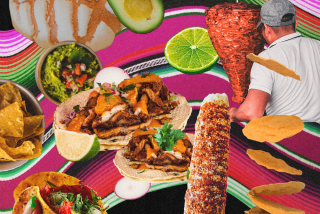The Devil Is in the Ingredients
- Share via
Food and love are linked almost everywhere in the world. The mother feeding her child. The special intimacy of the family meal. These are universal, almost archetypal, images.
But what makes the food-love nexus so potent, so romantic, is the addition of sin. It happened, of course, in the biblical tale of Adam and Eve. The Old Testament describes the Edenic fruit as “being good to eat,” but God prohibited its consumption. When Eve’s curiosity gets the better of her and she takes a bite, humanity is expelled from Paradise.
The story’s images are seared into the subconscious: Eve’s glistening lips, the hypersexual apple aswirl in mystical hues, the serpent’s flickering tongue. Never mind that the Bible does not directly connect the forbidden fruit to sex any more than it suggests it was an apple. Both characterizations were apparently added later for political purposes. The idea stuck and led to permanently conflicted feelings connecting food and sex, particularly among Christians.
“It is pleasures above the belt,” (by which they meant the stomach) that leads directly to pleasures below the belt, was one popular medieval saying. So monks listened to readings from the Bible to help keep their minds off the pleasure of their meal. St. Jerome defined a true lady as one who was never so promiscuous as to dine in public, and his acolytes were required to eat alone in darkened rooms.
Meals were to be endured, not enjoyed, and anything that glorified the act was heresy. “Man is, by nature, not a sauce eater,” opined one authority.
Tomato sauce, for instance, aroused all sorts of ecclesiastical outrage because its slut-red hues were seen as sexualizing the dinner table.
Even cutlery was questionable. When the European princess who popularized the fork died of a horrible disease, the clergy of Venice proclaimed it punishment from God for the way she’d glamorized dinner by conveying “morsels to her lips by means of little golden forks with two prongs.”
The result was that poor cookery became a virtue in and of itself, while anything delicious was thought to come straight off the devil’s plate.
Take the quintessential Valentine’s Day gift of chocolate. The Aztecs took its sublime flavor as a sign of sacred character and restricted it to royalty. European colonialists, however, perversely considered it too good to be good and banned it forthwith.
The first attack came in San Cristobal de las Casas, Mexico, where a Catholic priest outlawed the “heathen brew” because it distracted his parish from the word of God.
The chocolate drinkers struck back, first with a sword fight during the priest’s sermon and later by poisoning him. The poison was apparently delivered via the priest’s daily cup of chocolate.
“Since he was obviously an enemy of chocolate in the Church,” the lady suspected of killing him supposedly said, “it is no surprise that it did not agree with him.”
When the beverage arrived in France it was viewed in much the way we do cocaine -- an addictive South American drug that leads to depravation and uncontrollable sexual urges -- and court usage was alternately criminalized and legalized, depending on the regime’s moral tone. There were even “chocolate babies,” viewed with the same horror we viewed cocaine’s “crack babies.” These dark-skinned children were said to have come from cocoa junkies consuming their brew while pregnant. A more likely explanation was the fad for having Moroccan male servants serve aristocratic ladies exotic brews like coffee and chocolate in private Moorish-style tents set up in living rooms.
This belief that chocolate is a drug/aphrodisiac lingers despite scientists’ repeated debunking. The scientists are wrong, of course, or at least simple-minded. Anything delicious or beautiful, be it food or art or a human face, intoxicates. It transforms our perception of the world, however briefly, and renders everything more lovely.
The romantic meal of Valentine’s Day, the flowers, all are meant to achieve this moment by reminding us of that Edenic memory of the first meal in the perfect place with our first and last and most beautiful mate.
More to Read
Eat your way across L.A.
Get our weekly Tasting Notes newsletter for reviews, news and more.
You may occasionally receive promotional content from the Los Angeles Times.









